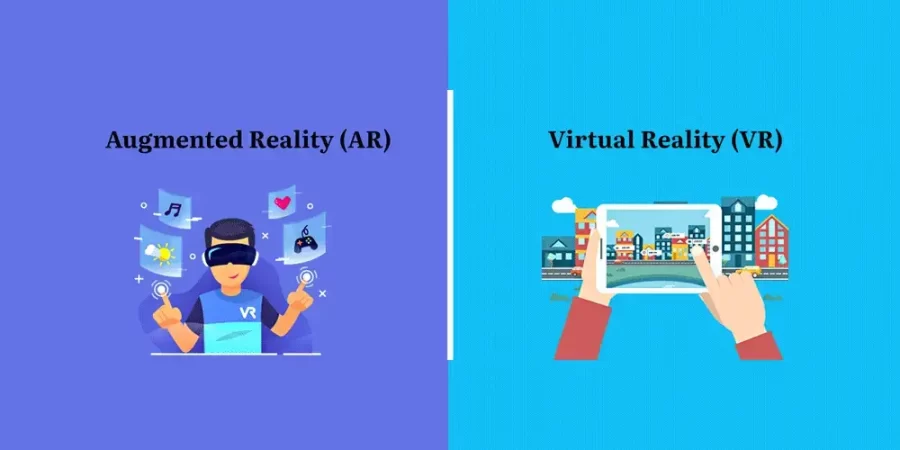Beginners Guide: How To Use Virtual And Augmented Reality For Online Marketing?
Virtual reality (VR) and augmented reality (AR) are rapidly emerging technologies that are changing the way businesses approach online marketing. Both VR and AR have the potential to offer unique and engaging experiences for users, which can help to build brand awareness, increase customer engagement, and ultimately drive sales. In this article, we will discuss some of the ways that businesses can use VR and AR for online marketing, as well as some best practices for implementing these technologies.
First, it’s important to understand the difference between VR and AR. VR is a fully immersive experience where the user is transported to a digital world, while AR overlays digital information onto the real world. VR is typically used for gaming and entertainment, while AR is used for things like product visualization and education. Both technologies can be used for online marketing, but in different ways.
One way businesses can use VR for online marketing is by creating a virtual showroom or store. This allows customers to explore a product or space in a virtual environment, giving them a more immersive and engaging experience than they would get from traditional online shopping. For example, a furniture retailer could create a virtual showroom where customers can explore different furniture layouts and styles, and even see how the furniture would look in their own home. This can help to increase customer engagement and ultimately drive sales.
Another way to use VR for online marketing is by creating virtual events. For example, a car manufacturer could host a virtual launch event for a new car model, where customers can experience the car in a virtual environment and even take it for a virtual test drive. This can help to build excitement and anticipation for the product, and ultimately drive sales.
In the case of AR, businesses can use this technology to enhance the customer experience by allowing them to see what a product would look like in the real world before making a purchase. For example, an interior designer could create an AR app that allows customers to see how different furniture and decor would look in their own home, before making a purchase. This can help to increase customer engagement and ultimately drive sales.
Another way to use AR for online marketing is by creating interactive experiences. For example, a fashion retailer could create an AR app that allows customers to try on different outfits virtually, giving them a better idea of how the clothes would look on them before making a purchase. This can help to increase customer engagement and ultimately drive sales.
When implementing VR and AR for online marketing, it’s important to keep a few things in mind. First, it’s important to ensure that the VR or AR experience is high quality and runs smoothly. This means that the graphics should be crisp, the controls should be responsive, and the overall experience should be seamless. It’s also important to make sure that the VR or AR experience is easily accessible to a wide range of users, as not everyone will have access to VR or AR hardware.
Another important consideration is the cost. Creating a VR or AR experience can be expensive, so it’s important to make sure that the investment is justified by the potential return on investment. It’s also important to make sure that the VR or AR experience is compatible with the target audience, as not all customers will be interested in this type of technology.
It’s important to measure the success of the VR or AR campaign. This means tracking things like engagement, conversions, and sales, in order to see if the VR or AR experience is having the desired effect on the target audience.
VR and AR are rapidly emerging technologies that can be used for online marketing in a variety of ways. They offer unique and engaging experiences for users, which can help to build brand awareness, increase customer engagement, and ultimately drive sales. However, it’s important to
keep in mind that creating a VR or AR experience can be expensive, so it’s important to make sure that the investment is justified by the potential return on investment. Additionally, it’s important to ensure that the VR or AR experience is high quality, easily accessible, and compatible with the target audience.
Another way businesses can use VR and AR for online marketing is by creating branded content. For example, a travel company could create a VR video that takes users on a virtual tour of a destination, giving them a taste of what it would be like to visit in person. This can help to build excitement and anticipation for the destination, and ultimately drive sales. Similarly, a beauty brand could create an AR try-on feature, where customers can virtually try on different makeup looks before making a purchase.
Another way to use VR and AR for online marketing is through experiential marketing. This means using VR and AR to create memorable and immersive brand experiences. For example, a luxury car brand could create a VR test drive experience, where customers can experience the car in a virtual environment, and even customize it to their liking. This can help to build brand loyalty and ultimately drive sales.
One important aspect to keep in mind when using VR and AR for online marketing is data privacy and security. It’s important to ensure that user data is collected and stored safely, and that it’s in compliance with relevant data privacy laws and regulations. It’s also important to be transparent about how user data is collected, stored, and used.
In addition, it’s important to test and optimize the VR and AR experiences. This means testing the experiences with a sample group of users, and then making changes based on their feedback. This can help to ensure that the VR and AR experiences are effective and engaging.
VR and AR are powerful tools for online marketing, and they can be used in a variety of ways. They offer unique and engaging experiences for users, which can help to build brand awareness, increase customer engagement, and ultimately drive sales.
However, it’s important to keep in mind that creating a VR or AR experience can be expensive, so it’s important to make sure that the investment is justified by the potential return on investment. Additionally, it’s important to ensure that the VR or AR experience is high quality, easily accessible, and compatible with the target audience.
It’s also important to be transparent about data privacy and security, and to test and optimize the VR and AR experiences. As the technology continues to advance, it will be exciting to see how businesses continue to use VR and AR for online marketing in new and innovative ways.
Here are some detailed bullet points that summarize the key points discussed in the article about how to use virtual and augmented reality for online marketing:
- Virtual reality (VR) and augmented reality (AR) are rapidly emerging technologies that are changing the way businesses approach online marketing. Both VR and AR have the potential to offer unique and engaging experiences for users, which can help to build brand awareness, increase customer engagement, and ultimately drive sales.
- VR is a fully immersive experience where the user is transported to a digital world, while AR overlays digital information onto the real world. VR is typically used for gaming and entertainment, while AR is used for things like product visualization and education. Both technologies can be used for online marketing, but in different ways.
- One way businesses can use VR for online marketing is by creating a virtual showroom or store. This allows customers to explore a product or space in a virtual environment, giving them a more immersive and engaging experience than they would get from traditional online shopping.
- Another way to use VR for online marketing is by creating virtual events. For example, a car manufacturer could host a virtual launch event for a new car model, where customers can experience the car in a virtual environment and even take it for a virtual test drive.
- In the case of AR, businesses can use this technology to enhance the customer experience by allowing them to see what a product would look like in the real world before making a purchase. For example, an interior designer could create an AR app that allows customers to see how different furniture and decor would look in their own home, before making a purchase.
- Another way to use AR for online marketing is by creating interactive experiences. For example, a fashion retailer could create an AR app that allows customers to try on different outfits virtually, giving them a better idea of how the clothes would look on them before making a purchase.
- When implementing VR and AR for online marketing, it’s important to ensure that the VR or AR experience is high quality and runs smoothly. This means that the graphics should be crisp, the controls should be responsive, and the overall experience should be seamless. It’s also important to make sure that the VR or AR experience is easily accessible to a wide range of users.
- Another important consideration is the cost. Creating a VR or AR experience can be expensive, so it’s important to make sure that the investment is justified by the potential return on investment. It’s also important to make sure that the VR or AR experience is compatible with the target audience.
- Finally, it’s important to measure the success of the VR or AR campaign. This means tracking things like engagement, conversions, and sales, in order to see if the VR or AR experience is having the desired effect on the target audience.
- Another way businesses can use VR and AR for online marketing is by creating branded content. For example, a travel company could create a VR video that takes users on a virtual tour of a destination, giving them a taste of what it would be like to visit in person.
- Another way to use VR and AR for online marketing is through experiential marketing. This means using VR and AR to create memorable and immersive brand experiences.
- One important aspect to keep in mind when using VR and AR for online marketing is data privacy and security. It’s important to ensure that user data is collected and stored safely, and that it’s in compliance with relevant data privacy laws and regulations.
- It’s important to test and optimize the VR and AR experiences. This means testing the experiences with a sample group of users, and then making changes based on their feedback. This can help to ensure that the VR and AR experiences are effective and engaging.
- Another way to use VR for online marketing is by creating virtual tours of a location or property. For example, a real estate company could create a VR tour of a property, allowing potential buyers to explore the property in a virtual environment before deciding to visit in person.
- VR and AR can also be used for providing virtual training and education. For example, a construction company could use VR to train workers on how to safely operate heavy machinery, or a medical company could use AR to provide virtual anatomy lessons for students.
- A key advantage of using VR and AR for online marketing is that it can generate buzz and create a sense of exclusivity and uniqueness. This can help to differentiate a brand from its competitors and create a more memorable experience for the customer.
- When creating a VR or AR experience, businesses should consider the user journey and ensure that the experience is intuitive and easy to navigate. The experience should be engaging and provide value to the user.
- It’s also important to consider how the VR or AR experience will be promoted and marketed. Utilizing social media, influencer marketing, and targeted advertising can be effective ways to reach the target audience and generate interest in the experience.
- As VR and AR technology continues to advance, businesses should stay up to date with the latest developments and explore new and innovative ways to use these technologies for online marketing.
In conclusion, VR and AR are powerful tools for online marketing, and businesses can use them in a variety of ways to create unique and engaging experiences for users. These technologies can help to build brand awareness, increase customer engagement, and ultimately drive sales.
However, businesses should be aware of the cost and potential limitations of VR and AR and ensure that the investment is justified by the potential return on investment. Additionally, it is important to consider data privacy and security, and to test and optimize the VR and AR experiences in order to ensure they are effective and engaging.





Leave a Reply